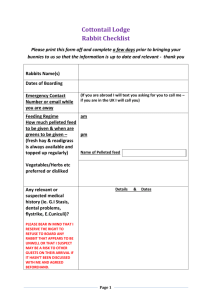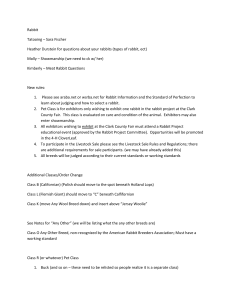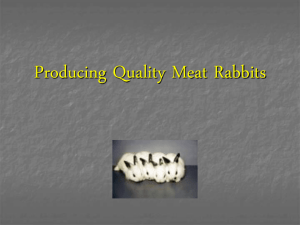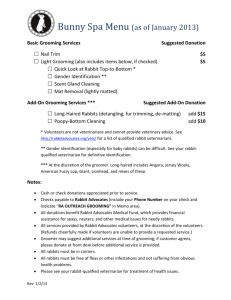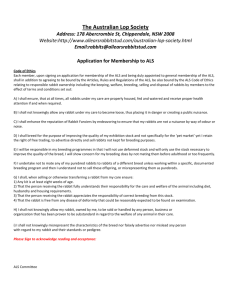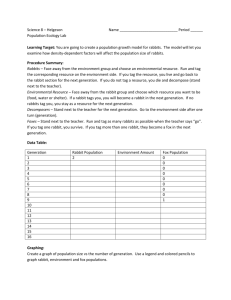NW Colorado rabbit s.. - Colorado State University Extension
advertisement
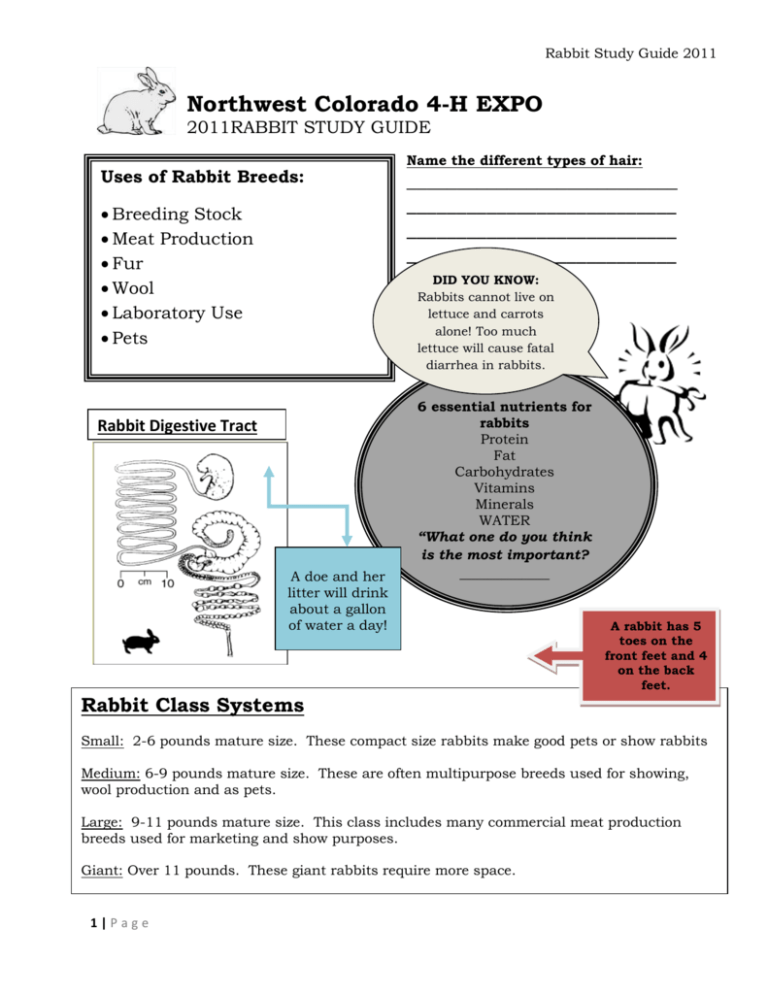
Rabbit Study Guide 2011 Northwest Colorado 4-H EXPO 2011RABBIT STUDY GUIDE Uses of Rabbit Breeds: Breeding Stock Meat Production Fur Wool Laboratory Use Pets Name the different types of hair: ___________________________ ___________________________ ___________________________ ___________________________ DID YOU KNOW: Rabbits cannot live on lettuce and carrots alone! Too much lettuce will cause fatal diarrhea in rabbits. Rabbit Digestive Tract A doe and her litter will drink about a gallon of water a day! 6 essential nutrients for rabbits Protein Fat Carbohydrates Vitamins Minerals WATER “What one do you think is the most important? _____________ A rabbit has 5 toes on the front feet and 4 on the back feet. Rabbit Class Systems Small: 2-6 pounds mature size. These compact size rabbits make good pets or show rabbits Medium: 6-9 pounds mature size. These are often multipurpose breeds used for showing, wool production and as pets. Large: 9-11 pounds mature size. This class includes many commercial meat production breeds used for marketing and show purposes. Giant: Over 11 pounds. These giant rabbits require more space. 1|Page Rabbit Study Guide 2011 Parts of a Rabbit It is important to be able to identify the parts of your 4-H animals. Study this picture and practice identifying the parts. DID YOU KNOW: A rabbit is the only animal that will produce 10 times its own weight in one year. . Rabbit Conformation Ideal Ears Belled Ears Open Carried Ears 2|Page Ideal Tail Side Carried Tail Screw Tail Ideal Legs Ideal Hips Inward-Bowed Legs Rough Hips Outward-Bowed Legs Not Enough Rise Rabbit Study Guide 2011 the names and aoffew characteristic of cattle: Know the namesKnowing and a few characteristic different breeds of different breeds of horns) rabbitswith are important. Angus: These animals are polled (no a black coat. They are know for their carcass quality, milking and mothering and their reproductive traits. California: Thisinlarge, commercial breed originated in They are the most popular breed of cattle the United stated. the United States. Coat is white with colored Herford; These animals arecolor red with white faces and ears, Match the breeds of rabbits can feet, be tail polled and or nose. horned. Point They color were is chocolate brought or the black. United with the pictures. Mature ranges from 8-10 ½ pounds. It has good Stated in weight 1817. They became popular due to their fur quality, is popular show and bred for meat. hardiness, feed efficiencyfor and disposition. Simmental: Charolais English Lop: This large, English breed has a semi-arch A. Gelbvieh type profile. Ears are carried low on head with no Limousin noticeable crown. They are at least 21 inches from tip to tip. Fur is medium length, fine and silky. Mature weight is 9 pounds and over. B. C. D. E. F. 3|Page Mini Lop: This small, compact breed originated in Definitions: Germany as a sub-breed of English Lop. Body is massive Bull: Male Fur animal and thick set. is glossy, medium length, thick and Heifer: Female animal that has not4yet dense. Mature weight ranges from ½ calved to 6 ½ pounds. It Steer: has a goodCastrated meat andmale fur quality and is popular for show. Fattening: The process of deposition energy in the form of fat within the body tissue Gestation: New Zealand: This large, commercial breed originated in The length of time an animal is pregnant the United The States. include black, red and white. Cud: bolusVarieties of eaten feed which is regurgitated Fur is fly back. Mature weight ranges from 10-11 and further chewed. pounds. This breed exemplifies meat production. Expenses: items that you have purchased for your project Profit: when your income is larger than your expenses when your are larger yourwith a Loss: English Angora: Thisexpenses is a medium woolthan breed, income compact type profile. It originated in England. Coat is a Breakeven: Thewith price per pound need to cover your silky texture guard hairsyou protecting the undercoat. total expenses Coat color is rich with many varieties. Mature weight Intravenous-applying medication for the benefit of the ranges from 5 to the 7 ½blood pounds. animal directly into flow Subcutaneous: Applying medication for the benefit of the animal American Lop: This small, compact breed under Fuzzy the skin originated in the United States.forWool is dense, slightly Intramusclar: applying medication the benefit of the coarse, appears in a variety of colors and is evenly coved animal into the muscle with guard hairs. Mature weight is 3-4 pounds. Rabbit Study Guide 2011 Animal Health It is very important to be able to monitor the health of your animal and be able to properly treat the animal as need. The disease believed to cause the greatest loss of rabbits is coccidiosis. Never give medication to your animal without a parent , vet or your 4-H leader. To properly give medication to animals you must be able to understand the medication label. Be able to identify: o Name of the drug o Name of the distributor o Storage instructions o Withdrawal time o Quantity of contents o Active ingredients o Cautions and warnings Rabbit Ailments & Disorders Coccidiosis Snuffles 4|Page Ear Canker Sore Hocks Malocclusion Vent Disease Weepy Eye Wry Neck Mange Rabbit Study Guide 2011 Definitions: Roughage: High fiber low energy feeds (example: hay) Concentrates: High energy low fiber feeds (example: corn) Conformation: The shape and design of an animal Junior Doe: A female that has not had a litter Buck: Male animal Doe: Female animal Kit: A new baby rabbit Kindling: A female rabbit giving birth to a litter of kits Gestation: The length of time a mother carries her litter Molt: Act of shedding or changing fur Colostrum: the first milk that a calf gets from its mother. It is rich in nutrients and antibodies Fattening: the process of depositing energy in the form of fat within the body tissue Dressing Percent: the amount of lean meat on a carcass. The more meat the higher the cutability Breakeven price: the price per pound you need to cover your total expenses Pedigree Record- The family tree of each individual rabbit that shows sires and dams. Immunity: the ability to resist infection. 5|Page

